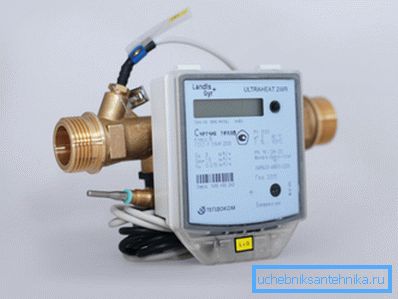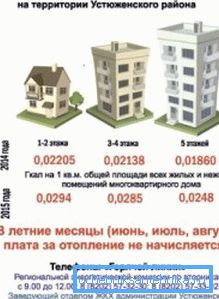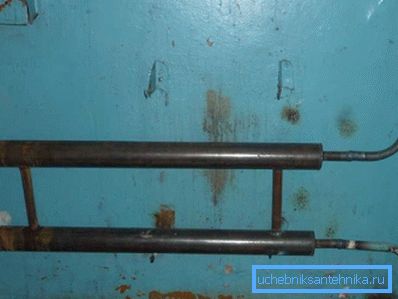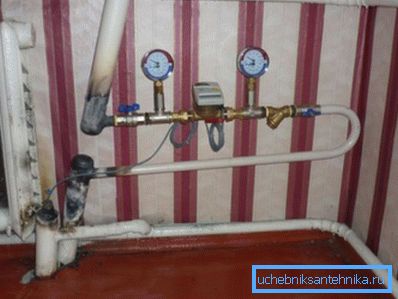Standard of heat consumption for heating: the meaning of the
What is it - the norms for heating? Which parameters are normalized? What values can take the standard consumption of heat energy for heating? Let's try to answer these questions.

Basic concepts
Before explaining the meaning of the concept we are studying, let us get acquainted with several related terms and definitions.
Gigacaloria
Traditionally, thermal energy is measured in kilowatt-hours. However, for calculations for heat in public utilities, another value is used - gigacalorie, or 10 ^ 9 calories. It is this unit of measure introduced because it is comparable to the monthly consumption of heat energy for apartment buildings; kilowatt-hours, more familiar to the consumer, would mean prohibitively large numbers in bills.
Note! The physical meaning of the concept of gigacalorie is simple: it is the amount of heat required to heat 1000 tons of water by 1 degree on the Celsius scale at atmospheric pressure.

Temperature standards
The boundaries of the allowable temperature in residential premises can be found in the sanitary rules and norms (SanPiN) number 2.1.2645-10. What heating regulations are currently in effect?
| The room | Optimum temperature, C | Allowable temperature, С |
| Living room | 20 - 22 | 18 - 24 |
| Living room for the temperature of the coldest five-day week in the year below -31C | 21–23 | 20 - 24 |
| Kitchen | 19 - 21 | 18 - 26 |
| Toilet room | 19 - 21 | 18 - 26 |
| Bathroom, combined bathroom | 24 - 26 | 18 - 26 |
| Staircase | 16 - 18 | 14 - 20 |
| Interroom corridor | 18 - 20 | 16 - 22 |
If the minimum heating rate in an apartment is not met, its owner has the right to demand a proportionate reduction in the payment for heating. The condition of recalculation is an act drawn up on the basis of temperature measurement by representatives of housing and public utilities.
Calculation scheme
The rate at which tenants pay for heat energy can be formed in several ways. In most regions of the country, tariffs are revised approximately once every three years.

However: under certain conditions, the heating norms in an apartment, including heat tariffs, may change more flexibly. Typical examples are the transfer of a house from one organization to the balance of another or a transition to other norms of state regulation, which in 2014-2015 can be observed in the Crimea.
What could be billing schemes?
Let's give some examples.
- In the presence of a flat heat meter, the apartment owner pays for the actual heat consumption of his apartment. In the calculations, the fixed price of gigacalories is used (in different regions it amounts to 1500 - 2000 rubles).
- If a common heat meter is installed in the house, the total heat consumption is derived from a change in its readings, which is distributed to the apartments in proportion to their area.
- Finally, if heat meters in a house and apartments are absent in principle, instead of the actual energy consumption, the calculation uses the norms of heat energy consumption for heating, derived on the basis of several factors:
- Region. It is clear that in Yakutsk heat consumption will be more than in Anapa.
- Quality insulation of the facade of the building.
- Number of floors. The more of them, the less heat loss per unit area.
- The type of glazing.
- Terrain and prevailing wind direction. They have a strong effect on heat loss through ventilation.
By the way: far more often the standards for the consumption of heat energy for heating are valid throughout the entire region, regardless of the type of building.

Definition
So, the standards for the consumption of thermal energy for home heating are the estimated amount of thermal energy that is necessary to maintain normalized temperatures in them. They are measured in gigacalories per square meter per month. Their values are set by local authorities.
Examples
We present specific values currently in force for some cities of the Far East.
| Locality | Monthly standard of heating, Gcal / m2 |
| Khabarovsk | 0.0359 |
| Komsomolsk-on-Amur | 0.0343 |
| Amursk | 0.0325 |
| Nikolaevsk-on-Amur | 0.0348 |
| Chegdomyn, one-story houses built in 1999 and earlier | 0.0654 |
| Chegdomyn, five-story houses newer than 1999 | 0.0222 |
Comment: the example of Chegdomyn clearly shows the effect of the introduction of new requirements for thermal protection of buildings. According to the given norms, the values of heat loss in new and old houses differ threefold.

Recalculation
Even in homes without heat meters, where there is a fixed standard for heating, with a sustained temperature regime in apartments, recalculation can be performed. It is carried out in cases where the winter temperatures were significantly different from the calculated ones. In an unusually mild winter, you will be returned a part of the payment made earlier, and in a particularly severe one - alas, they will issue an additional invoice.

General house needs
A number of common areas of a residential building need heating along with apartments. This includes landings and lobbies, wheelchairs and garbage chambers. For these rooms, the heating standard is much lower than for residential ones; However, this heat someone needs to pay.
Who is responsible for the maintenance of common premises - it is not difficult to guess: its cost is included in the bills for heat supply of apartments.
In the most common case - when only a common house heat meter is installed, there are no individual ones - your share in the heating payment for the whole house (including common premises) is calculated as the product of the cost of all the heat energy consumed by the house and the ratio of the area of your apartment to the total living area of the house.
For example, an apartment's area is 50 m2, the total cost of heat consumed by the house meter is 50,000 rubles, and the total living area of the house is 1000 m2. Your payment this month will be 50000 * (50/1000) = 2500 rubles.

Heating savings
Is it possible to reduce monthly payments for heat without abandoning central heating?
The only way to do this is to install an internal heat meter.
In new houses with horizontal wiring, instructions for installing it yourself are extremely simple: the meter itself is placed in the gap of the feed line of the apartment filling, the return pipe is supplied with a thermal sensor.
But in the houses of the old buildings, where each radiator is connected to its own riser, there will be a number of problems.
- The total cost of installing meters for 3-4 radiators will be at least 45 - 60 thousand rubles, which means a very long payback period of the project.
- Counters on the liner account for heat consumption through the radiator; however, the riser also contributes to heating.
- A natural solution - to arrange horizontal wiring from one riser with a single metering device - is also unacceptable in most cases. A sharp increase in heat extraction from one riser will make your neighbors freeze.

The conclusions are disappointing: as long as the standards for apartment heating and the tariffs attached to them remain unchanged, there is no reason to wait for a reduction in heat bills.
Conclusion
We hope that our material has helped the reader to understand the pricing scheme. Current standards for residential heating for your region can be found at the resource of the local administration or heat selling organization (see also the article Specific heat consumption for building heating: familiarity with the term and related concepts).
Successes!